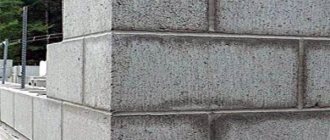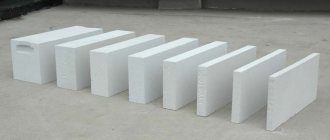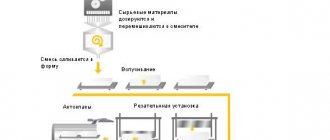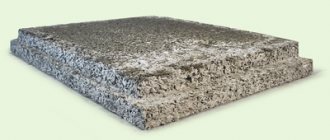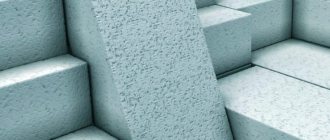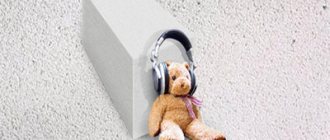Modern aerated concrete belongs to the category of lightweight cellular concrete. Its internal structure is similar to a sponge, consisting of air bubbles with a diameter of 1 to 3 mm. Due to its structure, the material, despite its large dimensions, is lightweight and easy to process.
There are 2 types of production: autoclave using steam and non-autoclave . Products of the first type are stronger, but also more expensive.
We will give the typical sizes of gas blocks and tell you about their main parameters.
Specifications
The main technical characteristics are presented in the table:
| Aerated concrete parameters | |||
| Dry density, kg/m³ | 400 | 500 | 600 |
| Strength class | B 2.0 | B 2.5/B 3.5 | B 3.5 |
| Frost resistance grade, cycles | F 35 | F 75/F 100 | F 100 |
| Thermal conductivity in dry state, W/m°C | 0,096 | 0,12/0,12 | 0,14 |
| Vapor permeability, mg/(m×h×Pa) | 0,24 | 0,28/0,24 | 0,23 |
| Drying shrinkage, mm/m | — | 0,37/0,37 | 0,33 |
The service life of buildings made of aerated concrete according to the STO 00044807-001-06 is 125 years. The first major overhaul is in 55 years.
Standard block sizes
Aerated concrete blocks are produced in two geometric types: classic rectangular and with a U-shaped cross section . Each type has its own standard sizes.
Rectangular
The parameters are:
- L = 600 , 625 mm.
- B = 85 , 100 , 150 , 200 , 240 , 300 , 400 mm.
- H = 200 , 250 mm.
U-shaped
The sizes are as follows:
- L = 500 , 600 mm.
- H = 250 mm.
- B = 200 , 250 , 300 , 375 , 400 mm.
These blocks are indispensable for making window and door lintels, stiffeners, and various supports.
In addition to the geometric dimensions of one block, the manufacturer, as a rule, indicates other important parameters:
| Name | Pallet size with blocks (B×L×H) | Number of blocks on one pallet | Volume of one block, m³ | Weight of one block depending on density (kg) W = 25% | |||
| m³ | PC. | 400 | 500 | 600 | |||
| 100×250×600 ave. | 750×1200×1500 | 1,44 | 96 | 0,015 | 8,2 | 10,12 | 12,2 |
| 150×250×600 ave. | 750×1200×1500 | 1,35 | 60 | 0,0225 | 12,2 | 15,2 | 18,3 |
| 200×250×600 ave. | 750×1200×1600 | 1,44 | 48 | 0,03 | 16,2 | 20,3 | 24,3 |
| 250×250×600 ave. | 750×1200×1200 | 1,35 | 36 | 0,0375 | 20,25 | 25,4 | 30,4 |
| 300×250×600 inc. | 750×1200×1500 | 1,35 | 30 | 0,045 | 24,3 | 30,4 | 36,5 |
| 350×250×600 ave. | 750×1200×1200 | 1,26 | 24 | 0,0525 | 28,35 | 35,5 | 42,5 |
| 375×250×600 inc. | 750×1200×1200 | 1,35 | 24 | 0,0563 | 30,3 | 38 | 45,6 |
| 400×250×600 inc. | 750×1200×1600 | 1,44 | 24 | 0,06 | 32,4 | 40,5 | 48,6 |
| 450×250×600 ave. | 750×1200×1200 | 1,215 | 18 | 0,0675 | 36,25 | 45,5 | 54,7 |
| 500×250×600 ave. | 750×1200×1200 | 1,35 | 18 | 0,075 | 40,5 | 50,6 | 60,75 |
Calculation of the number of foam blocks 200x300x600 per cube
Today, the building materials market provides each client with one or another building material in abundance, and foam blocks are no exception. It is not enough to choose the size and number of foam blocks; it is also important to know how to deliver such bulky material to the construction site.
The question of delivery worries almost every builder. This article will describe in detail how the delivery process takes place and the entire initial stage of purchasing foam blocks for construction.
How many foam blocks are there in a cube?
The first thing you should take care of when purchasing foam blocks is counting the number of blocks that are needed for the construction of a particular object. This question is quite relevant both among professional builders and among newcomers to this business.
In order for the calculation of a certain number of foam blocks to be as accurate as possible, you must rely on the following parameters of the facility under construction:
- Length.
- Width.
- Height.
- Volume.
- Square.
Which brand is chosen for construction?
According to their intended purpose, concretes are distinguished according to GOST 25485-89 :
- Thermal insulation . Density D300 - D500 .
- Structural and thermal insulation . Density D500 - D900.
- Structural . Density D1000 – D1200.
Grades with a density below 500 kg/m³ are only suitable as a thermal insulation material. However, the D500 is located at the junction of the GOST and samples from trusted manufacturers meet all the requirements for materials for the construction of load-bearing structures and have high thermal insulation properties.
In addition to the economic benefits, grades of optimal density less and are easier to process and trim.
Walk through country villages, read thematic forums. Most aerated concrete structures in the private housing construction sector are built from D500 .
Calculating the mass of aerated concrete blocks
As already mentioned, we present the calculation using a specific example of a 200x300x600 gas block.
For calculations, the formula is used: mass (kg) = volume of aerated block (m3) x density indicator (kg/m3).
Let's do the calculation:
First you need to find out the volume of blocks from which the house will be built.
To do this, the length, height and width are converted into meters and multiplied by each other: 200 * 300 * 600 = 0.2 * 0.3 * 0.6 = 0.036 m3. Now you need to see how much the material was compacted. As mentioned earlier, the density value is indicated in the marking after the letter D. For example, let’s take 600. We carry out the calculation: 0.036 * 600 = 21.6 kg.
When calculating the load that the house will exert on the foundation, it is worth considering the possibility of using blocks with different sizes and strengths - their mass per 1 cubic meter is completely different.
Making calculations using a similar principle, we can calculate that a product with dimensions 200x200x500 and density 500 (0.2*0.2*0.5=0.02*500) will weigh exactly 10 kg.
Now you have learned what exact weight a gas block with the most common dimensions can have and how you can carry out calculations for a material with other characteristics. Feel free to calculate how much the house will weigh and carry out calculations of the bearing capacity of the foundation.
One of the varieties of cellular concrete is aerated concrete. It is mainly used in low-rise construction. In addition, the blocks are used for the construction of industrial buildings, warehouses, garages and utility rooms.
Types of aerated concrete
Aerated concrete products are divided into structural, structural-thermal insulating and insulating. Structural ones can be large in size and weight, they are highly durable, which allows the construction of buildings up to 3 floors high.
The brands of such gas blocks are from D900 to D1200. The aerated concrete block, which has less mass, is used to construct internal partitions. D350 brand gas block is fragile, so it is mainly used as insulation.
Like any building material, aerated concrete has both its pros and cons. Its positive properties are excellent heat and sound insulation, ease of processing, as well as frost resistance and speed of installation. A significant disadvantage is fragility and low bending strength.
Dependence of weight on size
The weight of an aerated concrete block depends on its density and dimensions.
In the State Standard there are several brands: D300, D400, D500, D600 and so on, where the number indicates the density of the product (kg/m3). The weight of a particular block can be determined by the formula: volume (in m3) multiplied by its density. So, for example, a 200x300x600 block of the D600 brand will weigh 21.6 kg.
Brand of aerated blockSize, mmWeight, kgPrice per m3, rublesD400250x200x62515,633350250x250x62519,533350250x300x62523,443350250x400x62531,253350250x500x62539,063 350D500200х300х60018,03400250х300х60022,53400200х40х60024,03400100х300х6009,03400200х250х60015,03400150х250х60011,33400D60020 0x300x60021,63450250x300x60027,03450200x400x60028,83450100x300x60010,83450200x250x60018,03450150x250x60013,53450
Physical and technical characteristics
When choosing an aerated concrete block for construction projects, it is necessary to take into account not only how much the aerated concrete block weighs, dimensions and price, but also its characteristics.
The quality of construction work and the safe operation of the facility directly depend on this. These main properties include thermal conductivity, frost resistance, dimensional deviation, compression and tension resistance. Let's give some data using the example of the D300 and D600 brands.
Characteristics D300D600 Thermal conductivity coefficient 0.0720.14 Vapor permeability coefficient 0.260.16 Drying shrinkage 0.30.3
Aerated block is an excellent building material. It is almost 20 times lighter and much cheaper than brick. So, if the average price of one m3 of aerated concrete is about 3,000 rubles, then 1 m3 of brick costs from 4,500 to 5,000.
Despite the fact that the construction market provides a large selection of wall and building materials, aerated concrete products attract developers not only with their appearance, ease of installation and processing, but also with an affordable price. Aerated concrete blocks are classified as lightweight stone materials, in comparison with monolithic concrete and brick, with the help of which the walls of the house are erected. The main components are cement, sand and lime. One of the important parameters of such a material is its mass. First of all, the weight of the aerated concrete block needs to be known to calculate the foundation of the house.
Fire safety
Low thermal conductivity ( GOST 31359 and GOST 30244 ) allows aerated concrete to be classified as a non-flammable building material of the fire hazard class - K0 (non-fire hazardous).
100 thick wall D500 brand blocks is capable of resisting fire for 3 1 fire barrier and used as a barrier to increase the degree of fire resistance of any building structures.
Tips for the driver
It is more reliable to transport cargo in pallets. When choosing pallet material, take into account the specifics of the product. Cardboard pallets are moisture-permeable - if the cargo leaks, problems cannot be avoided.
Experts advise paying attention to plastic pallets. The container is reusable, it can be washed and disinfected. The high price will be partly justified by their reusable use.
Before loading pallets into the truck, be sure to calculate the dimensions of the trailer and the number of pallet spaces. Remember that when the customer talks about pallets, he means standard sizes - that is, Euro pallets.
Vapor permeability: how to breathe in a room?
The coefficient µ (“ mu ”) of vapor permeability of aerated concrete depends on the density of the selected brand. Thus, the material indicator D500 is 0.20 mg/(m×h×Pa) according to SNiP II-3-79 .
This is a lot - aerated concrete “breathes” almost like wood. For example, the vapor permeability of chipboard is 0.12 - 0.24 mg/(m×h×Pa).
Choosing the right finish will help maintain the natural advantage of an aerated concrete block home. The vapor permeability of lime, plaster, and wall cladding materials must be no less than that of aerated concrete.
is not suitable in this case - it will “suffocate” the living space of the house, which will lead to the need to install a forced ventilation system.
Detailed information about expanded polystyrene can be found in our article - extruded polystyrene foam.
How much does a gas silicate block weigh on average?
The higher the density of the block, the correspondingly higher its weight. Thus, the blocks marked D700 have the largest mass - about 29 kg, D600 have a weight of 25 kg, and D500 - about 21 kg. Air humidity plays an important role. In wet weather, the weight of the blocks increases, since gas silicate blocks strongly absorb moisture.
Interesting materials:
What do webinars provide? What did the ancient Greeks and Romans give to the world? What does an administrator do in a VK conversation? What does a hotel manager do? What does a lie detector do? What does a disinfectant do? What does Enter do in Word? What does aftershave gel do? What does the geographer do in The Little Prince? What is the State Duma doing?
Radioactivity
Perhaps the most ridiculous myth regarding the material. Aerated concrete is no more (even less) radioactive than wood or gypsum ( Aeff = 54 Bq/kg) and corresponds to class 1 5 in terms of the total specific activity of natural radionuclides. ( 5 is prohibited because Aeff > 370 ).
The conclusion is obvious:
Proper transportation of bricks and aerated concrete blocks is not just a guarantee of the safety of wall materials, it is also a significant saving of money and time. Therefore, such a responsible process can only be entrusted to professionals.
Call our managers - they are those same professionals! They will help you make all the calculations correctly, select the appropriate manipulator and conclude an agreement on the most favorable terms.
Are you planning to deliver a large batch of wall materials to the site? Of course, a multi-ton long truck will not enter the site! Well, let him stand behind the fence - our maneuverable manipulators will instantly “drag” the entire load into place!
Specially trained operators will carry out the work of loading and transporting materials with impeccable quality - not a single brick will be damaged!

